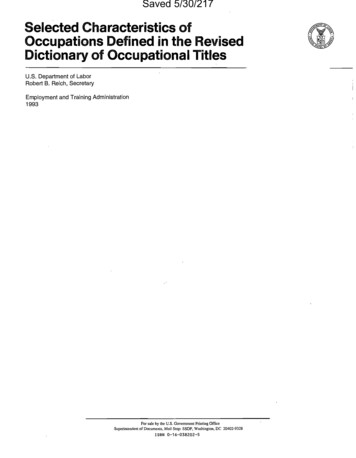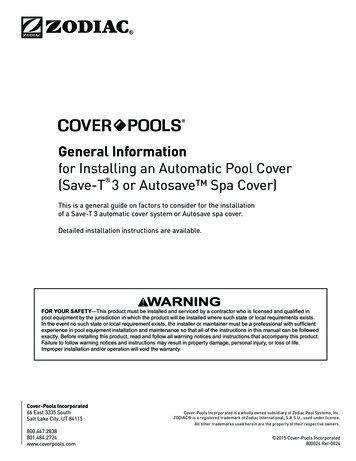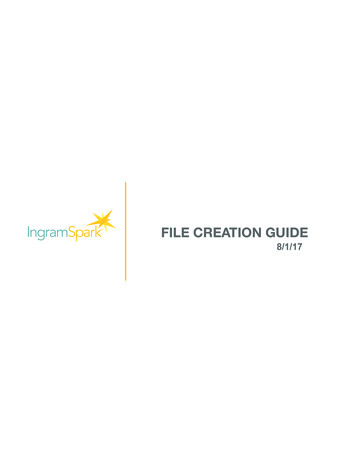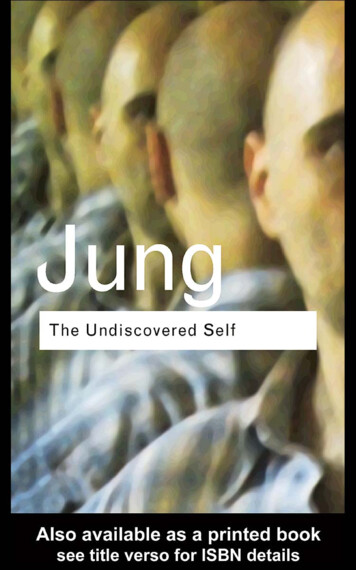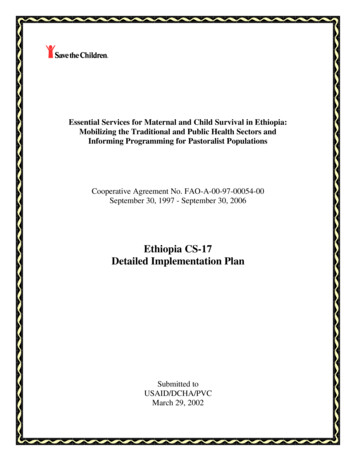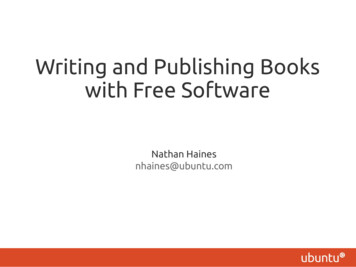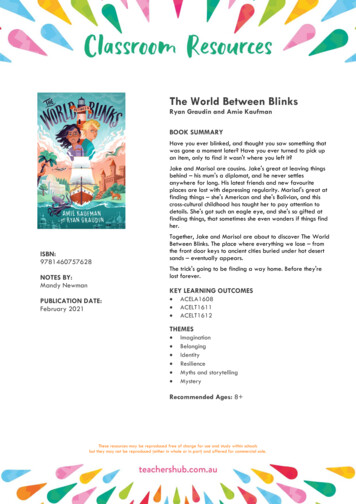
Transcription
COVER GOEThe World Between BlinksRyan Graudin and Amie KaufmanBOOK SUMMARYHave you ever blinked, and thought you saw something thatwas gone a moment later? Have you ever turned to pick upan item, only to find it wasn't where you left it?HEREISBN:9781460757628NOTES BY:Mandy NewmanSJake and Marisol are cousins. Jake's great at leaving thingsbehind – his mum's a diplomat, and he never settlesanywhere for long. His latest friends and new favouriteplaces are lost with depressing regularity. Marisol's great atfinding things – she's American and she's Bolivian, and thiscross-cultural childhood has taught her to pay attention todetails. She's got such an eagle eye, and she's so gifted atfinding things, that sometimes she even wonders if things findher.Together, Jake and Marisol are about to discover The WorldBetween Blinks. The place where everything we lose – fromthe front door keys to ancient cities buried under hot desertsands – eventually appears.The trick's going to be finding a way home. Before they'relost forever.KEY LEARNING OUTCOMESPUBLICATION DATE:February 2021 ACELA1608ACELT1611ACELT1612THEMES ImaginationBelongingIdentityResilienceMyths and storytellingMysteryRecommended Ages: 8 These resources may be reproduced free of charge for use and study within schoolsbut they may not be reproduced (either in whole or in part) and offered for commercial sale.
Before ReadingMysteries, myths and the power of storytellingA key theme in the novel is the power of storytelling to sustain myths and mysteries that otherwise might havebeen forgotten. By creating an imaginary world where those myths and mysteries from history are abundant,the authors show readers how to expand their imagination and use their favourite stories to inform creativethinking and writing tasks.The World Between Blinks is a magical place where all kinds of lost things (and people!) end up. Everywherethey turn, Marisol and Jake find real mysteries from history – plus a few they thought were only myths.The novel makes many intertextual references and travels through periods of time to include all sorts of famousstories, events, places and myths from all over the world, such as the Loch Ness Monster, Amelia Earhart, thefabled city of Atlantis and the Great Mogul Diamond. Examining all the different stories invites students toconsider different social, cultural and historical contexts, both in the real world and in fantasy settings. Share the myth of the Loch Ness Monster with the class.o https://en.wikipedia.org/wiki/Loch Ness Monstero -legendary-creature Ask the class whether they believe the myth and why they think so many people have believed for yearsand years that the myth could be true.o What does the story of the Loch Ness Monster tell us about the power of stories and myths?o Why do people like myths?o What is the appeal of fantasy? This Great Mogul Diamond weighed in at 737 carats, the largest ever to be mined in India. Ask the classto research the story.o Why is this story so interesting?o What is the appeal of the story? Why?Have a class discussion on why some places and people are more interesting than others. Tease out what arethe elements that create an interesting setting or character in a story. Is it about internal conflict, externalconflict, an air of mystery, remote location, the promise of a great prize, a problem, hazards, or qualities of acharacter such as courage and knowledge? Ask them to choose a famous person, place or myth to write about.o What fantastical elements could they add?o What type of mystery could they add?o How would this change the shape of the story?Discuss the title of The World Between Blinks. Look at the cover of the book. Ask the class to consider what the world between blinks could mean and how might it work.These resources may be reproduced free of charge for use and study within schoolsbut they may not be reproduced (either in whole or in part) and offered for commercial sale.
During ReadingWhere in the worldUsing a map of the world, pinpoint all the peoples, places and times mentioned in each chapter of the bookand discuss why each one is important. For example, in Chapter Two, Morris Island Light – a lighthouse onMorris Island in South Carolina in the United States – is mentioned, and in Chapter Five, Marisol and Jake findthemselves at The Crystal Palace, which was a famous structure in Hyde Park in London that burned down. Show the class pictures of some of the people and places mentioned, such as Amelia Earhart and Atlantis,and ask them to work with a partner to create a 300-word news story with pictures about why eachperson or place would be of interest to a child living in the 2020s.Words and musicExamine the musicality of language – punctuation, conjunctions, assonance, rhythm and rhyme. Composersshape meaning by using sound devices, which elevate and accentuate the sounds of words. Different forms ofpunctuation really add to the sound and effect of language. Ask each student to read out the below passage aloud. Ask them to pause every time there is a dash,question mark or exclamation mark.o How does this impact the audience?Not hear it?—yes, I hear it, and have heard it. Long—long—long—many minutes, many hours, many days,have I heard it—yet I dared not—oh, pity me, miserable wretch that I am!—I dared not—I dared not speak!We have put her living in the tomb!‘The Fall of the House of Usher’ by Edgar Allan PoeLook at various punctuation devices such as:Comma ,A short pauseColon :Shows that two parts of a sentence is equalSemicolon ;Replaces a conjunction (‘and’) in a compoundsentence; shows in intricate relationship betweenthe two parts of the sentenceDash —Indicates added emphasis, an interruption, or anabrupt change of thoughtThese resources may be reproduced free of charge for use and study within schoolsbut they may not be reproduced (either in whole or in part) and offered for commercial sale.
Assonance is another sound device. This technique is the deliberate repetition of vowel, or A E I O U, sounds,which complements the attitude of the speaker. For example: How now brown cow? So we’ll go no more a-roving - the assonance repeats the ‘o’ vowel. As a class read out:She sells sea shells by the sea shore.The shells she sells are surely seashells.So if she sells shells on the seashore,I'm sure she sells seashore shells.o Discuss why the assonance of the e sounds and the sibilance of s – enhances the sound and message ofthe tongue twister. Ask students to write their own tongue twister using assonance.Read the first page of The World Between Blinks out loud and look at how sound devices are used to shape orenhance meaning: THE WORLD BETWEEN BLINKS IS ALWAYS THERE.It is everywhere and it is nowhere.It is in every wreck, every abandoned lot, every city block, every scraggly patch of woods. It’s the placeyou glimpse out of the corner of your eye, reflected in rain puddles and car windows. Blink. There andgone. Shoved just out of the streetlight’s reach.People see it every day, but they rarely pay attention. The grown-ups are too busy doing grown-upthings—like ordering coffee or picking up dry cleaning—to stop and look, really look. Most kids are toodistracted to examine it for long. They see the boarded windows and the Danger: Keep Out sign postedby the entrance, and they shrug and go on with their lives.Most kids.But there are those who pause a little longer. The daydreamers—kids with burrs on their socks, who namesticks after legendary swords and call out the names of lost cities in their sleep.They stare into the dark places: blink, blink. They see.Using this passage as a model, ask students to write about the place they go to in their imagination. Askthem to write 15 sentences and to use punctuation, assonance, rhyme, rhythm, repetition and short and longsentences to create a composition which evokes a strong emotion or reaction, e.g. beauty, love, fear,anger.Setting the sceneSetting the scene of a story is very important. Good writers use sensory detail to establish the mood of asetting. Read this passage from The World Between Blinks – what senses do the writers appeal to?MARISOL LOVED THE AIR AROUND THE OCEAN.It smelled mostly of salt, yes, but there were so many other things happening inside it too. Sunscreen andcrying seagulls and driftwood discoveries and waves washing castles back into sand. One breath held allof this.p. 3These resources may be reproduced free of charge for use and study within schoolsbut they may not be reproduced (either in whole or in part) and offered for commercial sale.
Invite students to create a 150-word scene in a story set by the sea. Encourage them to answer thesequestions and include the below details in their setting.o What can the character observe? Colours, textures, objects?o What can the character hear? Sounds – alarm clock, train, baby sleeping?o What can the character feel? Touch – fabric? Temperature – hot?o What can the character smell? Daffodils, jasmine, sweat, salt?o What can the character taste? Basil, pickles, tar, metal, blood?After ReadingIt’s a mysteryHave a class discussion about pirates, treasure maps, time travel and mysteries on the following topic – why dopeople like reading mysteries?As a class, read this extract from Treasure Island by Robert Louis Stevenson, first published in 1882:I remember him as if it were yesterday, as he came plodding to the inn door, his sea-chest followingbehind him in a hand-barrow—a tall, strong, heavy, nut-brown man, his tarry pigtail falling over theshoulder of his soiled blue coat, his hands ragged and scarred, with black, broken nails, and the sabre cutacross one cheek, a dirty, livid white. I remember him looking round the cover and whistling to himself as hedid so, and then breaking out in that old sea-song that he sang so often afterwards:‘Fifteen men on the dead man's chest—Yo-ho-ho, and a bottle of rum!’in the high, old tottering voice that seemed to have been tuned and broken at the capstan bars. Then herapped on the door with a bit of stick like a handspike that he carried, and when my father appeared,called roughly for a glass of rum. This, when it was brought to him, he drank slowly, like a connoisseur,lingering on the taste and still looking about him at the cliffs and up at our signboard.Part1, Chapter 1Later, in Part 1, Chapter Six of Treasure Island, the narrator Jim, with others, find a treasure map:The paper had been sealed in several places with a thimble by way of seal; the very thimble, perhaps,that I had found in the captain's pocket. The doctor opened the seals with great care, and there fell out themap of an island, with latitude and longitude, soundings, names of hills and bays and inlets, and everyparticular that would be needed to bring a ship to a safe anchorage upon its shores. It was about ninemiles long and five across, shaped, you might say, like a fat dragon standing up, and had two fine landlocked harbours, and a hill in the centre part marked “The Spy-glass.” There were several additions of alater date, but above all, three crosses of red ink—two on the north part of the island, one in thesouthwest—and beside this last, in the same red ink, and in a small, neat hand, very different from thecaptain's tottery characters, these words: ‘Bulk of treasure here.’Over on the back the same hand had written this further information:Tall tree, Spy-glass shoulder, bearing a point to the N. of N.N.E.Skeleton Island E.S.E. and by E.Ten feet.These resources may be reproduced free of charge for use and study within schoolsbut they may not be reproduced (either in whole or in part) and offered for commercial sale.
The bar silver is in the north cache; you can find it by the trend of the east hummock, ten fathoms south ofthe black crag with the face on it.The arms are easy found, in the sand-hill, N. point of north inlet cape, bearing E. and a quarter N.J.F.Ask the students if they would like to find such a map, and why.What kind of treasure do the students think this map refers to?Marisol and Jake also find a treasure map: He studied the map, and she studied him, wondering if she should say something. “Jake?”“Yeah?”“I think we should search for Nana’s treasure.” Marisol tapped the X. “Let’s go on an adventure of ourown!”p. 14What do Marisol and Jake discover about their treasure map?What do they learn about treasure and where to find it?Through the process of looking for treasure, both Jake and Marisol learn important lessons, which might beconsidered treasure. What are those lessons?What does the reader learn about treasure and where it can be found?Is reading a process of finding hidden treasures?At the very end of the story, Jake says: Sometimes you hold on to things.Sometimes you lose them.And sometimes, just sometimes, you had to let go of something so you could find it again.What do you think Jake means by this?p. 296Ask students to create a multimodal treasure map using realistic and fantasy settings and characters that drawon the worlds represented in the text.Write a 150-word analytical paragraph about the appeal of mysteries and treasure maps to young readers.About the AuthorsAmie Kaufman and Ryan Graudin are two bestselling, award-winning authors united by their love of history,adventure, magical stories and lost places. Ryan has explored the ruins at Lake Titicaca in Bolivia, and Amiehas picnicked in the lost Roman city of Ostia Antica. When they learned about a vanishing island off the coastof South Carolina, and the lighthouse left rising alone from the waves, they knew they had a story to tell. Amielives in Melbourne, Australia with her husband, daughter and part-dingo dog. Ryan lives in Charleston, SouthCarolina with her husband, daughter and part-wolf dog. Neither of them have met a Tasmanian Tiger yet or have they?You can find Amie and Ryan online at amiekaufman.com and ryangraudin.com.These resources may be reproduced free of charge for use and study within schoolsbut they may not be reproduced (either in whole or in part) and offered for commercial sale.
stories, events, places and myths from all over the world, such as the Loch Ness Monster, Amelia Earhart, the fabled city of Atlantis and the Great Mogul Diamond. Examining all the different stories invites students to consider different social, cultural and historical contexts, both in the real world and in fantasy settings.


